Venturing Permanence:
Students' Center in Kandahar, Afghanistan. Windtower.
Facts: Open Competition „Luftschloss - 150 years ETH Zurich” | 1st Prize | 2004 | Execution in Bamiyan as ETH House of Science. -> See also: Plans&Text
ETH House of Science Bamiyan
Architecture: Ivica Brnic, Florian Graf, Wolfgang Rossbauer (Brnic, Graf, Rossbauer Architects, Zurich) | Building Physics Prof. Dr. Bruno Keller, Stephan Rutz (ETH Zurich) | Structural Engineer Prof. Dr. Joseph Schwartz | Construction ManagerAsef Alemyar, Herat and Rorschacherberg.
Client: ETH Zurich | Representation Client:Prof. Dr. Mario Fontana, D-BAUG (IBK) | Committee for further collaboration: Prof. Dr. Olaf Kübler, President emeritus ETH Zurich | President Committee Jubilee: Prof. Dr. Meinrad Eberle, Corporate Communications.
Windtower
in Kandahar.
The
building is situated on the new university grounds on the northern
outskirts of the city of Kandahar. A mosque dating back to the
Taliban regime stands to the south of the campus, integrated into
the campus for university use. Directly opposite, one can find
eleven completed buildings serving instructional and administrative
purposes. Ours is the last building in the area, standing a few
kilometres away from a rocky wall, functioning as a backdrop.
Further expansion of the university grounds is planned in the
area behind our building; a strategic centrality to echo its primary
function as a university building. The spacial program of the
new building shall be: Auditorium (100m2), Café (50m2),
Working space (80m2), Micro-apartments for guests.
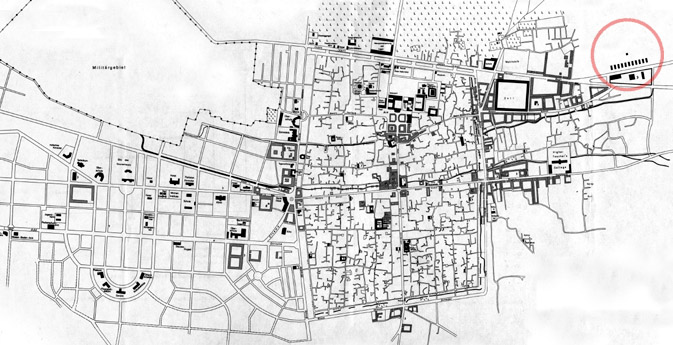
The
necessary criteria for the architectonic form-finding process
rely on Kandahar’s distinctive climactic circumstances.
The wind blows more-or-less regularly from the southwest and with
a force of ca. 3-4 metres/sec, its energy potentially useful to
us. The temperature varies from ca. 0°C in the coldest season
to approximately 40°C in summer. Humidity is slight, wavering
between 20% and 40% on any summer day. The amount of sunlight
hours is extremely high, nearing the maximum at all possible.
In response to these local specifications, we have developed a
building which comprises of a double-shelled system: a massive
and thus energy-saving („Trägheit”) clay brick
mantle, and an inner-built, reinforced concrete construction,
executed with ca. 30 cm-thick walls to prevent earthquake damage.
Due to its temporary use, it will be possible to isolate the building
on the inside with a 10 cm-strong straw-clay layer. The building
can be constructed easily with regional materials, and by local
construction companies.
Both
„shells” (layers) are arranged together so that a
space emerges, opening-up on the one hand a variety of sojourning
possibilities, and on the other a climate-regulating interstice,
comparable to a thermos flask.
The
stairway stretches along the brick wall in an upward movement,
caving it in and continually ridding it of its mass. In this way
the stairway narrows the wall and grants it its static sensuality.
The reinforced concrete construction retreats away from the brick;
the only points of contact occur where the rooms (within the construction)
need windows.
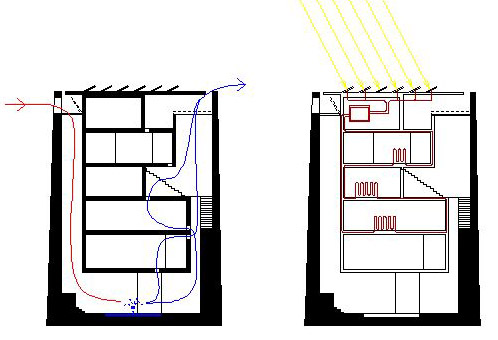
 Diagram:
Cooling Tower and Solar Energy Diagram:
Cooling Tower and Solar Energy
The
building is positioned against the direction of the wind and catches
the hot, dry desert air like a traditional windtower. In the above-mentioned
interstice, the air presses downwardly and deeply, cooling itself
through „evaporation-coldness” over the water basin.
Following this, it can then stream upwards and distribute itself
throughout the building to cool the rooms. Glass covers close
the interstice, now transformed into a kind of isolation space,
throughout the colder seasons. One would no longer sojourn in
the ground floor foyer, but would probably prefer the residential
top floor in winter. Here one can find straw mat covers and solar
panels, which (due to Afghanistan’s instable electricity
network) provide the building with electricity. It serves a small
water pump, among its other functions. This pump heaves water
from a stream into a deposit tank positioned on the roof of the
building. The water is heated here through solar collectors for
daily use. The building will be heated throughout the winter through
the use of solar energy sources.

 Roof
Terrace (Terrace, Technic Room) Roof
Terrace (Terrace, Technic Room)
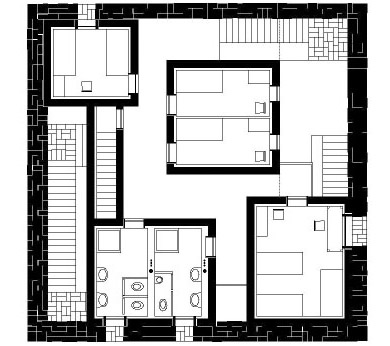
 First
Floor (Guest Rooms) First
Floor (Guest Rooms)

 Third
Floor (Offices) Third
Floor (Offices)
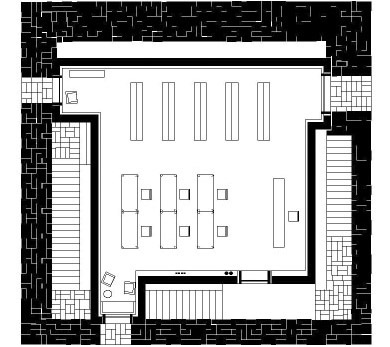
 Second
Floor (Library) Second
Floor (Library)
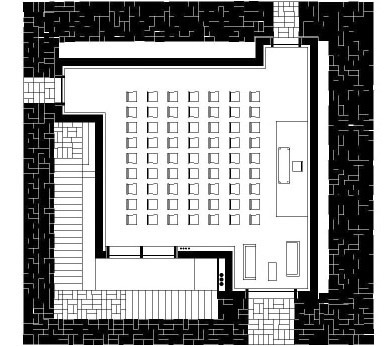
 First
Floor (Auditorium) First
Floor (Auditorium)
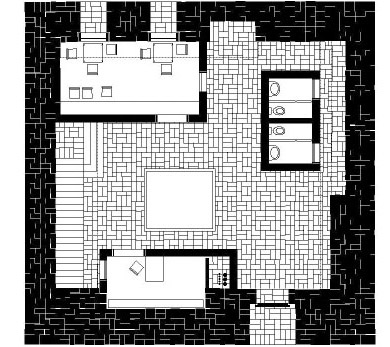
 Ground
Floor (Foyer, Cafeteria, Toilets) Ground
Floor (Foyer, Cafeteria, Toilets)
|